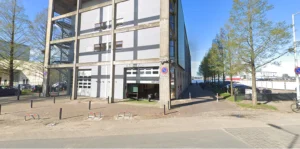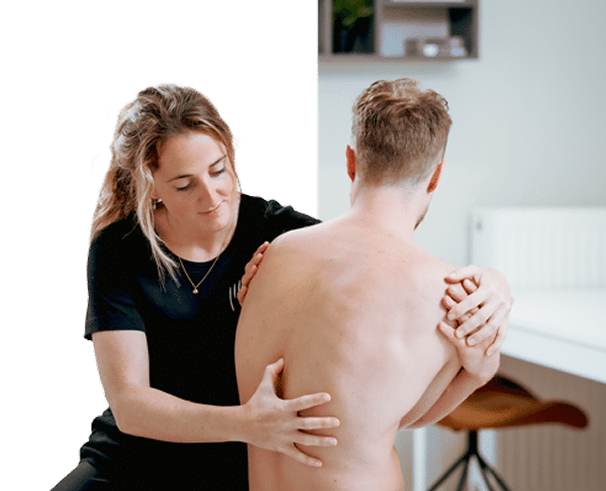What are groin problems
Groin pain is physical discomfort in and around the groin region. This area lies between the lower abdomen, hip and thigh and contains tendons, muscles and ligaments that work together when walking, turning and climbing stairs. Think adductors, iliopsoas and rectus femoris. Understanding the anatomy of the groin and the muscles of the groin involved helps provide targeted treatment. Pain may be localized or radiate to the lower abdomen, hip, buttock or upper leg.
Symptoms of groin pain
- Pain in right groin or pain left groin during walking, turning or accelerating
- Searing pain in groin and lower back after sitting or standing for a long time
- Sensitive attachment on inner thigh when pinched or adducted
- Starting stiffness and a stitch when sprinting, cowering or turning
- Lump on groin or lump in groin woman sensitive to pressure
- Pregnant and stitches in groin or stitch in groin pregnant due to changed load
Recognize these signs. Get your symptoms assessed early. Starting early accelerates recovery.
Causes of groin pain
Groin problems often arise from a combination of factors. Building up quickly with sprinting or kicking, little variation in posture or weak trunk forces can irritate the tendons of the adductors. Impaired hip control produces additional pull on the groin structures. Pain in groin after hip surgery or pain in groin after hip surgery is seen with altered movement patterns and muscle weakness. Sometimes there is a subcutaneous inflammation groin or groin fungus with blemishes groin that makes the skin sore. Itching in groin is common with fungal infection groin man. A lump in groin lymph node or inflamed lymph nodes in groin are part of an immune response. Lymph nodes groin inflamed can feel like a lump and are usually benign. A lump in groin STI can occur and requires assessment by GP or GGD. Persistent or growing swelling or marked fever are not part of sports injuries and require medical attention.
What you can do yourself
- Keep moving within pain limits and alternate sitting, standing and walking regularly
- Start with gentle hip and trunk mobility and add short walks daily
- Temporarily reduce explosive actions such as sprinting and kicking and opt for controlled power
- Perform adductor and hip stability exercises with low intensity and perfect technique
- Cool briefly for a recent strain and warm up gently later for exercise
- Does the pain persist or increase. Schedule an intake
Treatment of groin pain at The Physio Man
Our physical therapists specialize in groin pain. We start with an intake and analysis of your load, sports and work. We test hip mobility, adductor and trunk strength and coordination, and assess gait and turning technique. For skin and glandular problems, we coordinate with family doctor or dermatologist.
A treatment program usually consists of
- Targeted exercise therapy for hip and trunk strength, stability and coordination
- Construction of adductor load with clear pain limits and measurable steps
- Technique advice for turning, accelerating, kicking and lifting
- Mobilizations of hip and lower back as needed and tissue techniques around the groin
- Lifestyle advice on work posture, seat breaks and recovery times
Our goal is for you to move freely and pain-free again with a strong and resilient groin.
Sports and training without relapse
Keep training with a smart build-up. Start with gentle adductor activation and hip control. Then add controlled strength with squeezing a ball between the knees, bridge variations and later a skin support. Then work toward running forms, accelerations and directional changes. Quality of repetitions goes before quantity. Listen for post-pain. A mild reaction that subsides within a day is acceptable. Increase the next day means the stimulus was too high.
Skin and soft tissue in the groin
Not every complaint comes from tendons or muscles. Groin fungus or blemish groin gives redness, itching in groin and sometimes fissures. Fungal infection groin men often see in hot weather or tight and non-breathable sportswear. A subcutaneous infection groin can be painful and warm. Lumps caused by inflamed lymph nodes in groin and lymph node inflammation groin occur with infections elsewhere in the body. A lump in groin STI or persistent lump requires medical evaluation. Have doubts. Contact your primary care physician.
When immediate help is needed
- Sudden inability to support after a snapping or tearing sensation with rapid swelling
- Fever, feeling sick or rapidly increasing swelling in the groin
- Persistent pain in the groin with nocturnal worsening or unexplained weight loss
- Acute swelling or pain in groin in pregnancy with alarm symptoms
If so, contact your doctor immediately or call us for consultation.
Frequently Asked Questions
Is pain on the left different from pain on the right
The cause is usually similar. Think adductor strain, hip control or trunk strength. We examine the pattern and tailor your plan accordingly.
When is a lump in the groin cause for concern
A small lymph node often feels like a smooth lump that hurts when pressed and gets smaller in the following weeks. If there is persistent swelling, redness, fever or suspected lump in groin STI, contact your doctor.
What exercises help with groin pain
Start with controlled adductor activation, hip stability and trunk strength. Later add running forms and directional changes. We will create a schedule that fits your sport and work.
Can I keep exercising with groin pain
Yes if pain remains mild and subsides within twenty-four hours. Temporarily decrease volume and intensity and opt for technique. With increasing pain pause explosive stimuli and schedule an intake.
Your next step
Don’t carry around pain or uncertainty unnecessarily. With a clear diagnosis and a smart plan, you’ll work focused on recovery and get back to your level safely.
Make an appointment at The Physio Man now and work with us to build a strong, stable and pain-free groin region.
Share this article:


